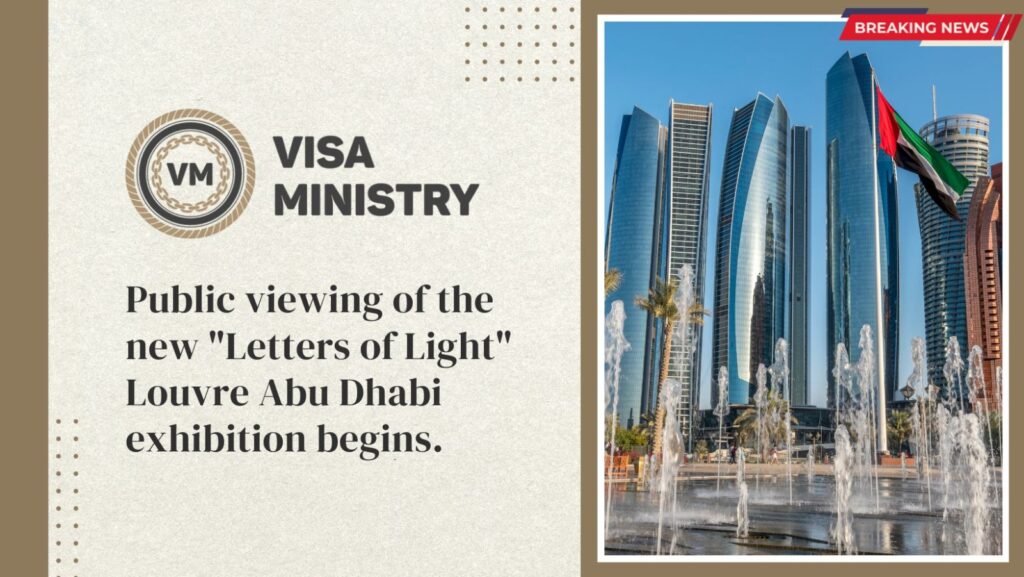Letters of Light presents some of the earliest sacred scriptures of the three monotheistic religions from 13 September 2023 to 14 January 2024. cooperation with the France Museums and the Bibliothèque nationale de France
The newest exhibition at the Louvre Abu Dhabi, Letters of Light, was officially opened by H.E. Mohamed Khalifa Al Mubarak, the organization’s chairman. Letters of Light, which includes some of the earliest scriptures from the three monotheistic religions, will go on display starting on September 13 and running until January 14, 2024.
Letters of Light, a collaboration between the Bibliothèque nationale de France and France Museums, examines the historical setting in which the holy books were composed, how they were transmitted over time, the scholarly and mystical practices connected to them, and their central significance in the development of human knowledge and the arts.
The exhibition is organized by Dr. Souraya Noujaim, Director of the Islamic Arts Department at the Musée du Louvre and former Director for Scientific, Curatorial, and Collections Management at the Louvre Abu Dhabi, and Laurent Héricher, Head of the Oriental Manuscripts Department at the Bibliothèque nationale de France.
Visitors will find significant and exquisite manuscripts of the Quran, Bible, and Torah, as well as artifacts from the collections of the Bibliothèque nationale de France, the Musée du Louvre in Paris, and the Louvre Abu Dhabi, among the more than 240 works of art on show. These items come from all around the world and include texts, images, graphic arts, three-dimensional artifacts, fabrics, and paintings. The exhibition also features The Unseen, a commissioned piece of art by Muhannad Shono that offers a modern viewpoint. Through a thoughtful experience, the Saudi visual artist’s thread-based installation figuratively joins the strands of the three religions.
“Letters of Light invites visitors to embark on a journey of profound reflection, exploring the intricate interplay between creative ingenuity and spirituality,” stated Manuel Rabaté, Director of the Louvre Abu Dhabi. This exhibition presents a variety of noteworthy items to highlight the shared origins of the three monotheistic religions, each an embodiment of beauty and knowledge, including exquisite texts like the Souvigny Bible, beautiful paintings like Giovanni Bellini’s Virgin and Child, and intriguing artifacts like the Key to the Kaaba. One will learn how these three religions have significant roots as they proceed through this intriguing exhibition, broadening their understanding beyond personal beliefs.
We are honored to have collaborated on this exhibition’s curation with the Bibliothèque nationale de France and France Museums, seamlessly linking and promoting strong cultural linkages, he continued.
According to Laurent Héricher, head of the Oriental Manuscripts Department at the Bibliothèque nationale de France, “This exhibition has been designed to emphasize the universality of Quranic, Biblical, and evangelical messages as well as the intrinsic ethical dimension of these three religions and their predominance in universal intellectual and artistic history. It will feature some of the oldest and most significant books and manuscripts, extraordinary illuminated, and marvelous calligraphy. This is completely in line with the Louvre Abu Dhabi’s universal dimension, which unites diverse cultures to illuminate these universal human experiences across civilizations, ages, and locations. We hope that taking tourists on this tour of the spiritual foundations of human history would inspire a moment of reflection and aesthetic feeling.
“By highlighting episodes and figures that are shared by all three monotheistic religions, we hope to deepen visitors’ understanding of these Holy Books, offering a retrospective on the rich history of sacred texts, exploring their forms, their languages, and the texts they contain,” said Dr. Souraya Noujaim, Director of the Islamic Arts department at the Musée du Louvre and former Scientific, Curatorial and Collections Management Director of the Louvre Abu Dhabi. A rare opportunity to view some of the most valuable artworks, monotheist sacred texts, and objects displayed side by side is provided by Letters of Light. These include items like the Blue Quran, which translates “Letters of Light” as the exhibition’s name in some chapters. This nearly contemporary calligraphy, with its golden characters and dark blue background, evokes concentration.
Artworks and manuscripts from the collection of the Louvre Abu Dhabi are among the exhibition’s masterpieces:
One of the most lavish ancient copies of the Quran that have persisted to the present is the blue Quran folio. The page, which consists of seven volumes, was most likely created in Kairouan, Tunisia, in the ninth or tenth century. The gilded letters represent the holy light transmitted by God’s word, while the dark blue paper represents the cosmic universe. There will be a specific passage that reconstructs six pages of the fragmented Blue Quran.
Quran palimpsest leaf in the Hijazi style; the lettering on the leaf is referred to as Hijazi. We are aware of it because to the Baghdadi author Ibn al-Nadim, who wrote in the 10th century. The word “Hijazi” identifies the script’s geographical origin as Mecca and Medina in the Hijaz region of the Arabian Peninsula, according to him.
A significant masterpiece that epitomizes the early Venetian Renaissance and Giovanni Bellini’s artistic vision is Virgin and Child. At the time, oil painting was a novel technique that set Venice apart from other Italian art centers. The use of a monochrome black background, which was uncommon for Bellini, rather than the traditional landscape highlights the piece’s intense use of color.
- Highlights from the partners of the Louvre Abu Dhabi are also on display, including:
- Late 12th-century Souvigny Bible featuring a depiction of Abraham’s bosom;
- Dead Sea Scrolls, the earliest known manuscripts of the Hebrew Bible, from the first century;
- about 1455–1456: Gutenberg Bible;
- Sultan al-Malik al-Nasir Faraj ibn Barquq, 1399–412: Key to the Kaaba;
- Collection of prayers on hexagonal pages, beautifully bound, with text that unfurls from the lower binding flaps, published in 1744.
Visitors to the exhibition may also see the Nano Bible, which astronaut Eytan Stibbe took to the International Space Station in April 2022 and is the smallest Bible ever to have traveled through space. Visitors will also know more about the Hebrew gravestone from Ras Al Khaimah, a significant archaeological find. The stele, which was found in the 1970s, bears the epitaph of a Ras Al Khaimah-based Jew. The United Arab Emirates’ first concrete proof of Jewish presence can be found here.
The Louvre Abu Dhabi will present a curatorial talk on September 12 from 5 to 6 p.m. as a part of the museum’s cultural programming. Laurent Héricher and Dr. Souraya Noujaim will share their perspectives on the work that went into making the exhibition come to life. From 6:30 to 7:30 p.m., a second discussion titled “Archaeology and Architecture” will be given by a fascinating panel that includes Dr. Timothy Power, Dr. Mark Jonathan Beech, and Manal Ataya.
The discussions, which will include national and international speakers from a variety of fields, will provide attendees the chance to learn more about the artworks and literary treasures chosen for the exhibition within the context of the Louvre Abu Dhabi as a universal art museum. The discussions will also focus on the modern thought and practice traditions that engage with the scriptures and their historical legacy.
At a later time, more information about the extensive cultural and educational program that will be presented in conjunction with the show. Visit louvreabudhabi.ae or call +971 600 56 55 66 for more details on the exhibit and to make reservations. With normal admission tickets to the museum, entry to the exhibition is free. Children under the age of 18 are not charged to enter the museum.
Source- Travel daily

